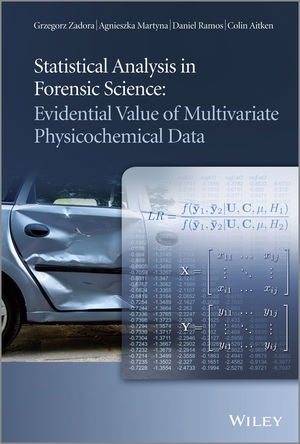Read more
Informationen zum Autor Grzegorz Zadora , Institute of Forensic Research, Krakow, Poland. Daniel Ramos , Telecommunication Engineering, Universidad Autonoma de Madrid, Spain. Klappentext A practical guide for determining the evidential value of physicochemical dataMicrotraces of various materials (e.g. glass, paint, fibres, and petroleum products) are routinely subjected to physicochemical examination by forensic experts, whose role is to evaluate such physicochemical data in the context of the prosecution and defence propositions. Such examinations return various kinds of information, including quantitative data. From the forensic point of view, the most suitable way to evaluate evidence is the likelihood ratio. This book provides a collection of recent approaches to the determination of likelihood ratios and describes suitable software, with documentation and examples of their use in practice. The statistical computing and graphics software environment R, pre-computed Bayesian networks using Hugin Researcher and a new package, calcuLatoR, for the computation of likelihood ratios are all explored.Statistical Analysis in Forensic Science will provide an invaluable practical guide for forensic experts and practitioners, forensic statisticians, analytical chemists, and chemometricians.Key features include:* Description of the physicochemical analysis of forensic trace evidence.* Detailed description of likelihood ratio models for determining the evidential value of multivariate physicochemical data.* Detailed description of methods, such as empirical cross-entropy plots, for assessing the performance of likelihood ratio-based methods for evidence evaluation.* Routines written using the open-source R software, as well as Hugin Researcher and calcuLatoR.* Practical examples and recommendations for the use of all these methods in practice. Zusammenfassung This book provides the methods and software to enable statisticians and forensic experts to work effectively with evidence evaluation methods. It also covers a collection of recent likelihood ratio (LR) approaches, explores suitable software toolboxes, and includes documentation and examples about how to use them in practice. Inhaltsverzeichnis Preface xiii 1 Physicochemical data obtained in forensic science laboratories 1 1.1 Introduction 1 1.2 Glass 2 1.3 Flammable liquids: ATD-GC/MS technique 8 1.4 Car paints: Py-GC/MS technique 10 1.5 Fibres and inks: MSP-DAD technique 13 References 15 2 Evaluation of evidence in the form of physicochemical data 19 2.1 Introduction 19 2.2 Comparison problem 21 2.3 Classification problem 27 2.4 Likelihood ratio and Bayes' theorem 31 References 32 3 Continuous data 35 3.1 Introduction 35 3.2 Data transformations 37 3.3 Descriptive statistics 39 3.4 Hypothesis testing 59 3.5 Analysis of variance 78 3.6 Cluster analysis 85 3.7 Dimensionality reduction 92 References 105 4 Likelihood ratio models for comparison problems 107 4.1 Introduction 107 4.2 Normal between-object distribution 108 4.3 Between-object distribution modelled by kernel density estimation 110 4.4 Examples 112 4.5 R Software 140 References 149 5 Likelihood ratio models for classification problems 151 5.1 Introduction 151 5.2 Normal between-object distribution 152 5.3 Between-object distribution modelled by kernel density estimation 155 5.4 Examples 157 5.5 R software 172 References 179 6 Performance of likelihood ratio methods 181 6.1 Introduction 181 6.2 Empirical measurement of the performance of likelihood ratios 182 6.3 Histograms and Tippett plots 183 6.4 Measuring discriminating powe...

